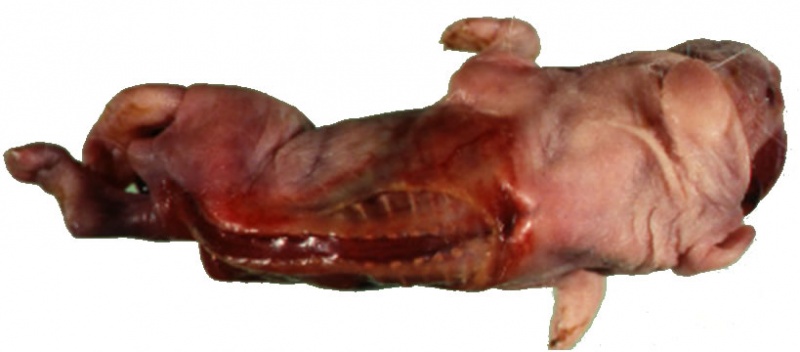File:Rabbitspinabifida1.jpg

Original file (819 × 360 pixels, file size: 46 KB, MIME type: image/jpeg)
Modified image showing The occurance of natural spinal bifida in rabbits
Able to use the image so long as you abide by their fair use policy outlined below.
Original image: URL: http://ag.ansc.purdue.edu/nielsen/www495/slides/spina.html
Source: Purdue University, West Lafayette, Indiana, USA
Fair Use Fair use is one of the exceptions in copyright which allows use of copyrighted materials without obtaining permission as long as the use can be considered fair. There is a four-factor analysis which must be applied to each use to determine whether the use is fair. Each factor is given equal weight. The goal is to achieve a balance between the rights of the copyright holder with the rights of the public. Fair use is also technologically neutral so the same analysis may be applied to any medium.
Copyright info purdue.edu Copyright Exceptions It is the decision of the individual who is using the work as to which exception is applicable. A good faith determination means that the individual must understand the exception they are selecting, be able to articulate it, and be able to reasonably apply it to their specific situation.
Fair use allows limited duplication and use of copyrighted works without the permission
of the owner for certain teaching and research purposes. The 1976 Copyright Act grants the "fair
use" of copyrighted materials for a variety of purposes, for the creation of new works, for
educational use, and for personal use.
Fair use applies to all copyrighted works regardless of the media in which they are fixed: print, electronic, or multimedia.
Fair use normally entails copying and is of three kinds:
• Creative fair use by authors who copy from other works to create their own work.
• Personal fair use by individuals who copy from works for their own learning or entertainment.
• Educational fair use by teachers, scholars, and students who copy for teaching, scholarship, or learning.
Fair use is determined on a case-by-case basis. To determine if a use is fair, consider the following:
• Is the proposed use non-commercial? Commercial uses are not fair use and require permission from the copyright holder.
• Is the work original to the author, or is itself a compilation of other works? If it is a compilation, fair use must be determined for each original work separately.
• How much of the work are you planning to use? The greater the amount of the work used, the more likely permission will be required. It is not permissible to copy entire books or articles without permission, since the more of a given work you use, the more you affect the market for it.
• What is the effect of your use on the market for the work? The greater the market effect, the less likely fair use will apply.
File history
Click on a date/time to view the file as it appeared at that time.
| Date/Time | Thumbnail | Dimensions | User | Comment | |
|---|---|---|---|---|---|
| current | 13:38, 18 September 2009 |  | 819 × 360 (46 KB) | Z3187802 (talk | contribs) | Modified image showing The occurance of natural spinal bifida in rabbits |
You cannot overwrite this file.
File usage
The following page uses this file: